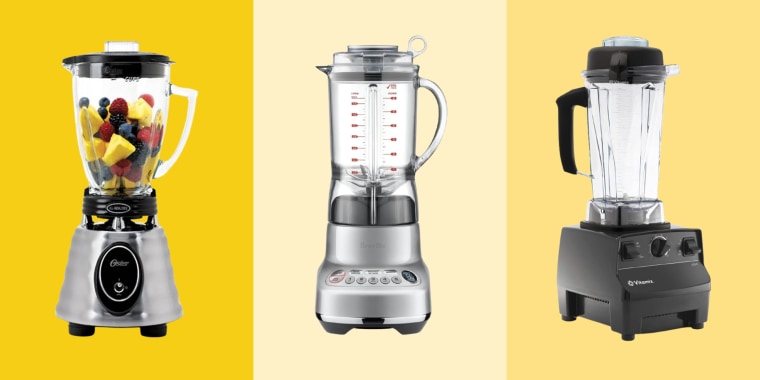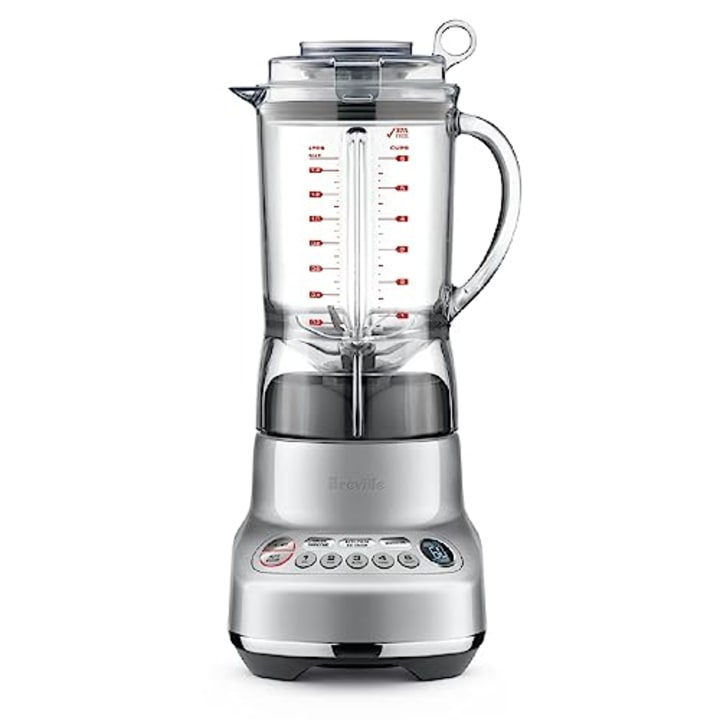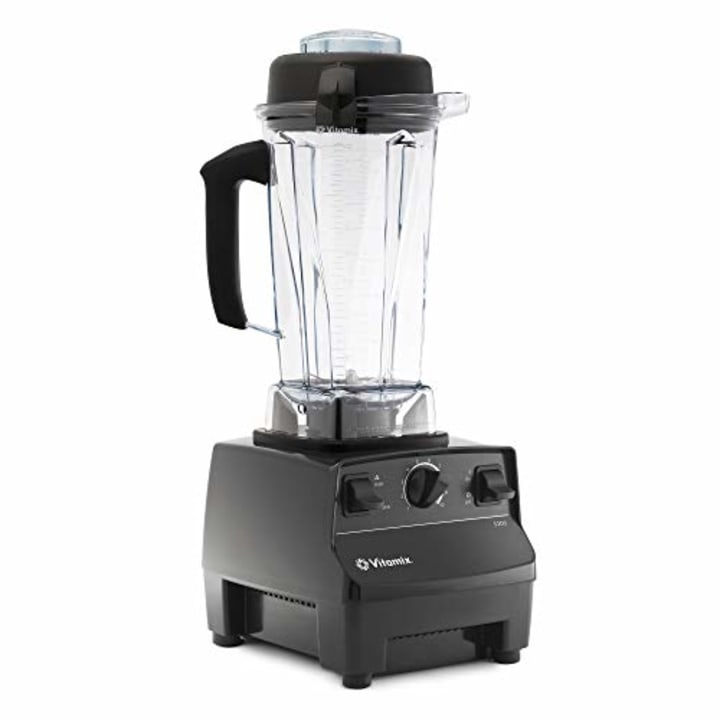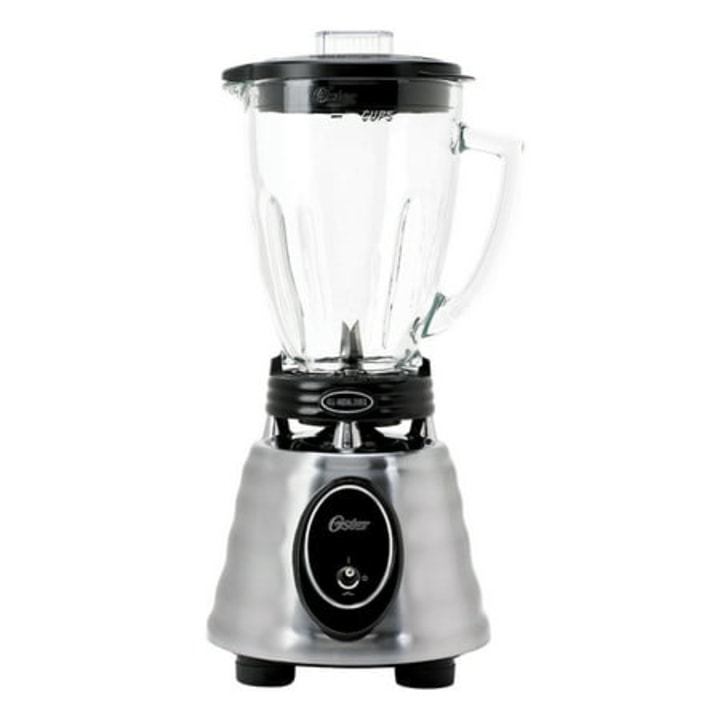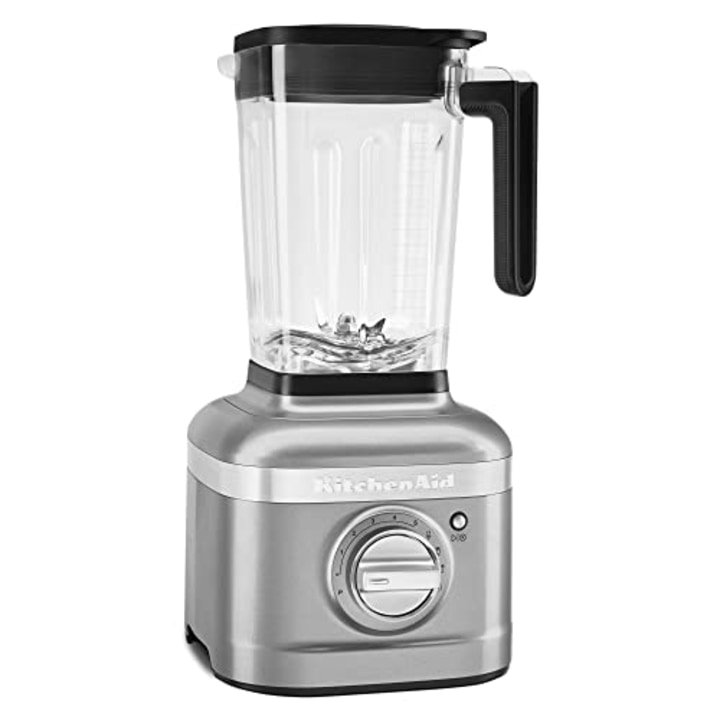A blender is a necessity when it comes to creating smooth, velvety textured soups, dips and smoothies. You can also use blenders to make nut butters, chop vegetables to ease meal prep, turn granulated sugar into powdered sugar and produce creamy sauces like hollandaise and aioli, according to Rebecca Miller Ffrench, author of “The Ultimate Blender Cookbook.”
To learn more about blenders and how to decide which one is right for you, we spoke to cookbook authors, chefs and blender engineers. Based on their advice, we selected the best blenders to buy and offer tips on what to look for and how to use and care for them.
SKIP AHEAD How we picked the best blenders | The best blenders | How to shop for blenders | How to use your blender safely | How to clean your blender
Our top picks
- Best overall/editor’s pick: Breville Fresh and Furious
- Best budget: Oster Classic Series Heritage Blender
- Best splurge: Vitamix 5200
- Best for protein shakes and smoothies: Ninja Twisti High Speed Blender Duo
- Best hand blender: Breville Control Grip Immersion Blender
How we picked the best blenders
The right blender depends on how often you plan to use it and what you plan to blend. When shopping, experts recommend keeping the following in mind:
Type: For occasional use, or to make smoothies, frozen cocktails or milkshakes, opt for a standard blender. If you plan to use it on a daily basis and blend things like kale for green smoothies, frozen strawberries and cream to make ice cream and almonds and peanuts to produce smooth nut butters, it’s worth investing in a high-powered, high-wattage model, says Tess Masters, author of “The Blender Girl,” “The Blender Girl Smoothies,” and “The Perfect Blend.” (She formerly worked with Vitamix and KitchenAid; any other mention of Vitamix and KitchenAid on this list were made independently.) For hot soups or pan sauces, a hand blender is the best choice since you can blend the entire amount at one time, while it is hot, in the pot.
Size: Blenders come in a variety of sizes. For this story we concentrated on blenders that have the capacity to hold ingredients for more than one person.
Features: Some features like preprogrammed settings or fitting under a standard countertop are nice, but not necessary. We have models with various features for you to choose from.
The best blenders
Below, we compiled the best blenders based on our experts’ guidance and recommendations. We also included picks that are highly rated with at least 4 stars from over 500 reviews.
Breville Fresh and Furious Blender
Bev Shaffer, former Vitamix chef, specifically likes this model for its blending performance and reasonable price point. Plus, I’ve used it to make smoothies and frozen pina coladas with great results in my own kitchen. It has five speed buttons ranging from mix to liquefy, and a cleaning button. It also has three programmed pads for smoothies, green smoothies and ice crushing or automatic pulsing. While it churns out even results, in my experience, it does leave some flecks behind when blending kale, for example. Its LCD display keeps track of time as you blend, plus the hard, clear plastic jug has measurements marked in red and a lid with an insert that serves as a small measuring cup to make following a recipe easy. The blade does not detach which makes hand cleaning difficult, though the jar and its lid are dishwasher-safe, according to Breville.
Capacity: 50 ounces | Dimensions: 6.9 x 8.3 x 17.7 inches | Weight: 8.5 lbs | Settings: 5 speeds, cleaning, smoothies, green smoothies, ice crushing/automatic pulse
Vitamix5200
This is the best option if you plan to use your blender frequently for tasks that a less powerful model cannot handle, like making peanut butter from nuts, and ice cream from frozen fruit and milk or cream. I’ve used it for many years and find that no other blender gives results that are as thick and smooth as the Vitamix. With its tall, tapered plastic blending jar, it creates an effective vortex, which pulls all of the ingredients down into the blades for even blending. In my experience, drinks like milkshakes and frozen daiquiris come out with an unmatched thick and velvety texture. After switching it on, you can either run it on high or use the variable control dial to adjust the speed. It also comes with a tamper, a long tool that you use to keep ingredients moving.
Unlike some other blenders on our list, there’s no pulse setting. While some experts say pulsing is an important technique to give you more control and prevent overblending, it's not absolutely necessary. Additionally, the blade’s not detachable for cleaning, plus the jar is not dishwasher-safe. (To clean, run your machine on a blending cycle with water and dishwashing liquid.) At over 20-inches tall, this blender does not fit under most standard-height cabinets with the jug attachment on the base.
Capacity: 64 ounces | Dimensions: 8.75 x 7.25 x 20.5 inches | Weight: 10.5 lbs | Settings: 10 variable speeds
Vitamix Propel 750
Ffrench recommends this model because it has a large capacity size, but still fits under a standard cabinet when not in use. Besides the shorter jar, the main difference between this model and the 5200 listed above is that, in my experience, it’s less effective at creating a vortex to get everything moving and blending evenly when you don't have a large amount of blending ingredients.
It’s powerful enough to produce sorbets, nut butter and flour as well as smoothies made of vegetables, according to Ffrench. In addition to its preprogrammed settings, it has 10 speeds and a pulse function. Like all Vitamix blenders, it has a blending jar and a nonremovable blade to clean by hand. It also comes with a tamper (a long wand-like instrument to keep the vortex moving), and has a 7-year warranty.
Capacity: 64 ounces | Dimensions: 9 x 7.5 x 18 inches | Weight: 10 lbs | Settings: 10 variable speeds, 3 preprogrammed settings and pulse
Oster Classic Series Heritage Blender
Like the Vitamix 5200, this model has a tapered jar that helps create a vortex, which is critical for good blending results, according to Masters. It's particularly good at creating icy drinks like margaritas and smoothies and grinding coffee beans, based on my experience. With only one switch that flips from high to low, it’s very easy to operate. The glass jar has an accompanying plastic lid that has a removable cap in the center with measurement markings for adding ingredients like liquor for cocktails. You can separate all of the blade parts to clean them in the dishwasher, according to the brand.
Capacity: 48 ounces | Dimensions: 8 x 7.50 x 16 inches | Weight: 8.3 lbs | Settings: High, low
KitchenAid K400 Variable Speed Blender
This KitchenAid model comes recommended by Shaffer for its ability to blend evenly. It has a control dial with five settings as well as a pulse feature and automatic programs for ice crushing, icy drinks, smoothies and cleaning. Whichever speed you select, the blender starts off slowly to prevent splatters, according to the brand. It has a heavy die-cast metal base that is available in seven colors and like other models on our list, a hard, clear plastic blending jar. You can remove the blade from the jar for cleaning, and along with all of the other pieces it is dishwasher safe.
Capacity: 56 ounces | Dimensions: 7.59 x 9.02 x 16 inches | Weight: 16 lbs | Settings: 5 variable speeds, pulse, preprogrammed settings for ice crushing, icy drinks, and smoothies, cleaning
Ninja Twisti High Speed Blender Duo
You don’t need to spend a lot of money on a blender if you are primarily going to make protein shakes, smoothies and milkshakes, according to our experts. Ffrench and Shaffer recommend Ninja as a reliable brand. This model, which has a 4.6-average star rating from more than 1,694 Amazon reviews, has five automatic settings and a pulse button, though it only has one manual speed. It also cannot blend hot liquids, according to the brand.
When you use the presets, a digital timer counts down so you know how much time is left. Plus, the lid has a built-in tamper to help keep ingredients moving around. To use it, twist the lid while blending, rather than stop the action as you do with most high speed blenders. For cleaning, remove the blade assembly from the jar and place all the parts in the dishwasher. In addition to a pitcher, it also comes with 24- and 16-ounce single serving cups.
Capacity: 34 ounces | Dimensions: 6.5 x 8.3 x 13.8 inches | Weight: 7 lbs | Settings: manual, pulse, extract, smoothie, frozen, spread, bowl
Breville the Control Grip Immersion Hand Blender
In my experience, this hand blender is powerful enough to puree tough root vegetables without splattering, and can blend smoothies made with ice and frozen fruit. Its rubber handle is comfortable to hold for several minutes and the power button is easy to press while gripping the handle. The bottom of the wand has a nonstick coating so it won’t scratch the bottom of a pot, plus with the exception of the accompanying whisk, all of the parts are dishwasher safe.
Capacity: Blending jug, 42 ounces; chopper bowl, 25 ounces | Dimensions: 6.2 x 7.5 x 12.4 inches | Weight: 3.8lbs | Settings: 15 speeds
How to shop for blenders
Blenders have a variety of features and sizes. First, you should consider how often you’ll use it, then consider the following:
Type of blender
A standard countertop blender is a solid choice if you want to make smoothies, frozen cocktails, soups and milkshakes for several people.
High-performance or high-speed blenders are better at handling heavy loads like raw root vegetables, nuts and lots of ice cubes and are typically more expensive than a standard countertop model. “For smoothies, cocktails and milkshakes, a standard blender is fine, but for pulverizing seeds, nuts, oats, and dried fruits or creamy textured ice cream, you’ll want a high speed model”, says Masters. In some cases, when using a high-performance blender for several minutes, it produces enough friction to heat up ingredients although it doesn’t actually cook them.
Portable blenders are smaller and less powerful versions of countertop models and are great for blending drinks for just one or two people using a small quantity of frozen fruit or ice cubes.
An immersion blender, which is also called a hand or stick blender, is a long, thin appliance with a grip on top and a blending blade on the bottom. You immerse the blade in a pot or bowl filled with ingredients that you want to puree. This type of blender is the best choice for pureed soups and sauces, according to Douglas Nash, general manager of cooking and food preparation for Breville. (While we include Breville blenders in this roundup, Nash did not provide any product recommendations.) It allows you to blend a large amount at one time in the pot, rather than wait for the ingredients to cool a bit and then transfer them to a blender jar. Immersion blenders are smaller and lighter than countertop models and are also easier to store.
Preprogrammed settings
Many blenders have settings or buttons for specific functions such as smoothies or ice crushing. When you press them, they run for a predetermined time at one or more speeds that are designed to give perfect results, according to Nash. They also allow you to attend to other tasks while the blender is running, although we recommend never leaving the room when blending.
However, experts are divided on the value of these preprogrammed settings since you don’t know exactly what ingredients the manufacturer used to program them and you may be using a smaller or large quantity of ingredients, which will skew the outcome.
When you choose your own time, you have more control over blending, says Shaffer.
Glass jars versus plastic jars
Most blenders and especially high-powered ones come with plastic jars made of a hard, clear plastic that is BPA-free and forgiving if dropped, according to Nash. In general, plastic jars have blade assemblies that you cannot remove or take apart for cleaning. While this may seem like a disadvantage as it is difficult to reach the bottom to clean around the blade, you can clean it by running the blender on its cleaning cycle with water and dishwashing liquid.
A nonremovable blade also eliminates the need for assembly and disassembly and the possibility that you won’t tighten the blade thoroughly, leading to leaks. Plastic jars are more lightweight, and therefore easier to pour from, and add less weight to the overall machine, which is convenient if you need to pull your machine down from high shelves or cabinets.
Variable speed
Variable speeds let you adjust the speed by turning a dial from one speed to another rather than pressing a button. This gives you quicker and smoother control over the blending process, according to Mark Gabrovic, executive chef for Jamba.
Wattage
While higher wattage blenders generally perform better, other factors like the blade, shape and size of the jar and the way they interact with each other, are more important factors than the motor in determining how well a model blends, according to Warren Preston, mechanical engineer manager for Breville. (Preston did not provide any product recommendations, despite Breville appearing in our list.) Only if all other factors are equal, you can directly compare wattage or the power of the motor to other models.
The difference between a blender and a food processor
Blenders and food processors have their own advantages, according to Ffrench and Shaffer. Blenders are best for drinks or dishes with a lot of liquid that you want to have a very smooth texture. They’re also great for soups and frozen drinks and any mixture that includes ice, though they give you less control than a food processor over the mixing process.
Food processors, which typically come with attachments for shredding and slicing, give coarser textured results, making them ideal for dishes like pesto or salsa that you want to be slightly chunky. As you have more control over the process, they are better for doughs you don’t want overworked, for chopping and mincing vegetables and for grinding nuts and Parmesan cheese that you don’t want pureed.
How to use your blender efficiently and safely
The order you add ingredients to the jar is critical, according Gabrovic. Liquid ingredients go in first to help get things moving, followed by the solid ingredients; add ice last to prevent it from freezing to the blade.
Don’t blend piping hot mixtures, as pressure can buildup. If you do, be sure to remove the cap in the middle of the lid to allow pressure to escape.
Avoid overfilling the blender to prevent the mixture from splashing out of the jar as it blends, says Derek Bissonnette, author of “The Ultimate Book of Soups and Stews."
How to clean your blender
Even if your blender manufacturer is dishwasher-safe, always hand wash the jug and blade, says Bissonnette. That’s because dishwasher cleaning will shorten the life of almost any blender jug, according to Nash. (It generally leads to rusting over time and eventually breaks the seal.)
All the experts we spoke with recommend using the cleaning setting on your machine, or if your blender doesn’t have one, running a blender half filled with water and a squirt of dishwashing liquid and then rinsing out the jar. That removes stubborn residue around the ribs and crevices of the jar and in the blade area. This also keeps you from having to clean around the blade, which can lead to injury. You’ll also want to clean the base and around the controls, where food can get stuck, says Gabrovic.
Meet our experts
At Select, we work with experts who have specialized knowledge and authority based on relevant training and/or experience. We also take steps to ensure all expert advice and recommendations are made independently and without undisclosed financial conflicts of interest.
Derek Bissonnette is a food photographer and stylist, former chef and author of “The Ultimate Book of Soups and Stews.” Derek has worked as a food stylist for Ninja. (He did not recommend any Ninja products for this piece.)
Rebecca Miller Ffrench is the author of “The Ultimate Blender Cookbook” and the founder of The Upstate Table, an event space and cooking school.
Mark Gabrovic is the executive chef for Jamba.
Tess Masters is the author of “The Blender Girl,” “The Blender Girl Smoothies” and “The Perfect Blend.” She formerly worked with Vitamix and KitchenAid. (Our inclusion of Vitamix and KitchenAid were made independently.)
Douglas Nash is the general manager of cooking and food preparation for Breville. (While we include Breville blenders in this roundup, Nash did not provide any product recommendations.)
Warren Preston mechanical engineer manager for Breville. (While we include Breville blenders in this roundup, Preston did not provide any product recommendations.)
Bev Shaffer is a former corporate chef for Vitamix. (Our inclusion of Vitamix in this piece, was made independently.)
Why trust Select?
Sharon Franke is a freelance journalist who specializes in kitchen equipment. For over 30 years, she worked at the Good Housekeeping Institute where she was Director of the Kitchen Appliances Lab. She has extensive experience trying blenders; for this story she spoke to seven experts and researched dozens of highly rated blenders online.
Catch up on Select's in-depth coverage of personal finance, tech and tools, wellness and more, and follow us on Facebook, Instagram and Twitter to stay up to date.
